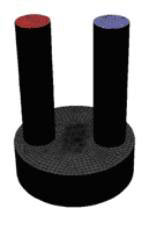

Electrochemical amperometric transducers monitor the electric current through the electrochemical cell and measure with high sensitivity the concentration of biological or chemical species. The present study examined the physical phenomena of mass transfer in the vicinity of an electrochemical sensor operating in flow conditions using a theoretical model. A 3-D geometry of the electrochemical cell (Figure 1) with computational fluid dynamic simulations of time dependent convection and diffusion are used. The study focused mainly on the contribution of the convection while migration, resulting from ion movement by the electric field and kinetics limitation (electrochemical or chemical), have been neglected. The flux of the electroactive species from a thin layer close to the electrode is calculated by numerical simulation. This theoretical calculated flux has been compared with the species flux obtained from the electric current measured by an amperometric experimental system (Figure 2). Comparison between the simulations and experimental patterns shows good agreement. Only a short delay at the onset of the measured flux was observed in the experimental results, when compared to the simulation data.
This theoretical study is the first step toward a complete design of an amperometric system for measurements of enzymes activity (and especially myocardial enzymes). The ability to understand and forecast the physical phenomena in the vicinity of the sensor help us in the present to built the complete electronic device and measurement. For achieving this goal we have purchased a computer and the components for the experimental system. Those components include a syringe pump and a fitting manual controller. The system also include integrated hardware and software that is currently under developing stage for monitoring in real time the electric current as a function of specific time.
 |
 |
| Figure 1: The 3-D geometry of the examined electrochemical sensor | Figure 2: Comparison between the species concentrationobtained by numerical simulations and experiments |